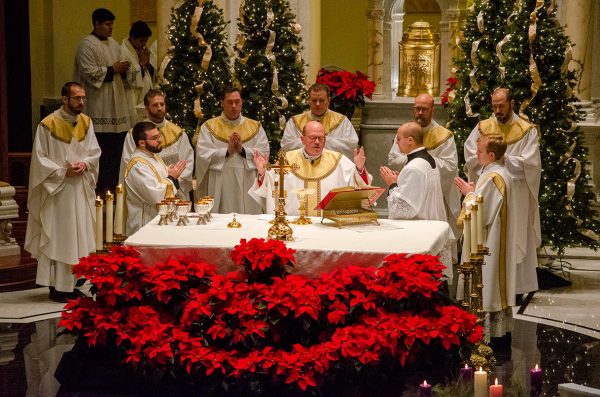Bishop Kemme: Christmas is history’s most consequential event

Bishop Carl A. Kemme was joined by seven priests of the Diocese of Wichita for the Christmas Eve Mass at the Cathedral of the Immaculate Conception in Wichita. A recording of the Mass is available at YouTube.com/DioceseOfWichita. (Advance photo)
The church celebrates the single most consequential event in human history, the birth of Jesus Christ, during the Christmas season, Bishop Carl A. Kemme said in his Christmas Eve homily at the Cathedral of the Immaculate Conception in Wichita.
Speaking from his cathedra and flanked by two transitional deacons, the bishop commented on Pope Francis’ apostolic letter, Admirabile Signum, or the enchanting image, a reflection published Dec. 1 by the Vatican about the meaning and importance of the nativity scene.
The holy father encourages the faithful to carefully display the nativity scene, or creche, Bishop Kemme said, because it is a “‘living Gospel, rising from the pages of Sacred Scripture.’ As we gaze in wonder and imagination into this scene, which has its origin in St. Francis of Assisi, we come to realize ‘that so great is God’s love for us that he became one of us, so that we, in turn, might become one with him.’”
The manger holds our food, too
The manger itself, a crude wooden structure where animals feed, he said, is significant because it holds “our food, the bread that came down from heaven.”
Each Mass repeats Christmas, Bishop Kemme added, where God feeds his people with nothing less than himself. “The word Bethlehem itself means house of bread. In this manger, Jesus is placed by his mother after his birth and as such brings the whole scene to life. Similarly, the church places the Eucharist, the gift of Jesus’ true body and true blood in our manger, in our hands, on our tongue – and with him, we come to life.”
The creche is a simple scene reflecting poverty, Bishop Kemme said, which was dear to the “poor man of Assisi,” poverty that was not a deterrent to God’s gift of life and love “but a meaningful condition that is uniquely and ironically suited to receive a gift of such profound mystery and human incomprehension.”
The shepherds represent the poor
The pope encourages the faithful to place figures, such as the shepherds, at the nativity scene that represent the poor, the lowly, and the powerless, he said.
“For as Pope Francis wrote, ‘The presence of the poor and the lowly in the nativity scene reminds us that God became man for the sake of those who feel most in need of his love and who ask him to draw near to them. Jesus, gentle and humble of heart, was born in poverty and led a simple life in order to teach us to recognize what is essential and to act accordingly.’”
Central to the creche are the figures of Mary and Joseph, Bishop Kemme said, the poor couple who followed God’s will. “Without them Christmas would never have happened as we have come to know it.”
He added that the Christmas scene, the holy father writes, proclaims that “the creche allows us to see and touch the unique and unparalleled event that changed the course of history.”
Those who gaze upon the nativity scene are astonished that God, like us, sleeps, takes milk from his mother, and cries and plays like every other child, Bishop Kemme said.
The pope continues in Admirabile Signum, “As always, God baffles us. He is unpredictable, constantly doing what we least expect. The nativity scene shows God as he came into our world, but it also makes us reflect on how our life is part of God’s own life. It invites us to become his disciples, if we want to attain ultimate meaning in life.”
The nativity, the greatest scene in history
We are encouraged to continually gaze upon the nativity scene, the bishop said, a display of the greatest moment in human history, “a moment spiritually frozen in time so that each succeeding generation will come to see with human eyes, the wonders of the Incarnation…let us come as they did and adore the New Born King, the Prince of Peace, the Savior of the World, our friend and our brother, the baby Jesus.”
In addition to the two deacons, seven priests of the Diocese of Wichita assisted the bishop in the celebration of the Christmas Eve Mass. A music prelude began 30 minutes before Mass. The Cathedral choir was led by music director Jim Jones, supported by Carole Pracht, the Cathedral organist, and was supplemented with strings, horns, and tympany.
